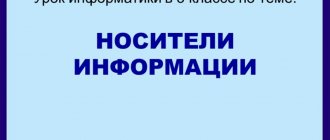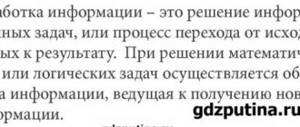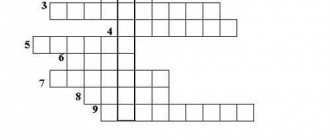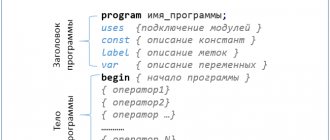The concept of information, its types, properties, methods of obtaining
Information is information about objects, events, natural phenomena, and processes. People receive information about air temperature, eye color, size of an object, smell of perfume, taste.
There are a great many ways for a person to obtain information. A person perceives information using the senses: eyes (vision), ears (hearing), tongue (taste), skin (touch), nose (smell).
The following types of information are distinguished according to the way it is perceived:
- visual information;
- audio information;
- olfactory information;
- taste information;
- tactile information.
(Source , , )
Visual is information that is perceived by a person through the eyes. Visual information is allocated 90%. The source of visual information can be a book, a traffic light, a TV, a billboard, etc.
()
Another type of information according to the way it is perceived is sound or auditory information. A person receives sound information using the ears. Sound information is transmitted via radio, TV, tablet, phone, etc. Animals also use a method of transmitting information in the form of sounds: a dog barks when it wants to inform a person about danger; A cat meows if it asks for food.
()
The nose helps receive olfactory information. Bring aromatic coffee to your nose, take a walk in the forest after the rain, or go to a bakery. The nose will pick up all the aromas. Thanks to olfactory information, a person draws conclusions about whether he likes a particular smell.
()
Taste information is perceived by the organs of the mouth. Taste buds in the mouth help detect the temperature and taste of an object that enters the mouth. As a rule, the source of taste information is food or medicine. Just remember the sour taste of ascorbic acid or the bitter taste of cough syrup that your mother gives.
()
Tactile or tactile information is the type of information that a person perceives through the skin.
Sources of tactile information:
- Plant. By touching the plant, you will learn that the ficus has smooth leaves, while the cactus has sharp spines.
- Liquid. When you touch a bowl of soup, feel whether it is hot or cold. After swimming in the thermal springs, you will find out that the water in the pool is warm. In the forest swamp the quagmire is viscous.
- Material. When you touch fur or silk, you will feel that it is soft and smooth. The sculptor works with viscous clay. And the cook uses a sharp knife.
- Sun. When you go outside on a sunny day, you will feel the sun's rays warming your skin.
- Wind. On a frosty day, the wind and snow tingle the skin of your face.
()
A person receives tactile information through the skin about the relief, texture, sharpness, softness, elasticity, rigidity, vibration or temperature of an object.
There are people who are visually impaired and cannot receive visual information. Braille, a relief-linear writing system, was invented for them. In this case, tactile information is of leading importance.
()
The role of the senses in the process of perceiving information is very important. Human senses as sources of information are not the most reliable when instruments such as rulers, scales, protractors, compasses, binoculars, barometers help obtain accurate data. Instruments provide a visual form of information: a protractor allows you to measure an angle, a scale allows you to measure mass, a barometer allows you to measure atmospheric pressure, a compass allows you to measure distance on a map, and binoculars allow you to observe distant objects.
()
Information properties include:
- relevance;
- objectivity;
- reliability;
- completeness;
- utility;
- clarity.
The importance of nonverbal means of communication in transmitting information
Unlike other forms of life, humans know how to communicate and even enjoy it. The main types of information also include verbal and non-verbal. The use of verbal and non-verbal channels for transmitting information depends on the person, his emotionality, and oratory. Verbal communication is communicating with words. Nonverbal information complements speech with gestures, posture, facial expressions, and intonation.
The interaction of verbal and non-verbal means of transmitting information ensures a high percentage of information transfer to the interlocutor.
()
Lesson in 3rd grade in computer science on the topic “Collecting information”
3
3rd grade, 1st quarter, collecting information
ABSTRACT
Lesson
on the subject “Informatics and ICT” in 3rd grade
Topic :
Collection of information.
§ 7 Objectives :
- update knowledge on the topic “A little history about actions with information”;
- to form an idea of the methods of collecting information;
- explain the term “observation”;
- develop students’ interest in the subject, cultivate dedication and hard work.
Lesson type:
1 hour – learning new material.
Means of education:
presentation “Collecting information”, textbook Matveeva N.V., R.T. – 3rd grade
Lesson structure, methods and time spent
| Lesson steps | Contents of the stage | Lesson time |
| Organization | Preparing students for the lesson, checking those present in the lesson | 0 — 3 |
| Motivation | Explanation of the topic, purpose, lesson plan | 4 — 5 |
| Updating knowledge | 1. How do we know what ancient people knew? 2. Is it possible to find out what ancient people did from their drawings? 3. Tell us what you know about how ancient people transmitted information over long distances. 4. Create and tell a short story about how a person can convey information without using words. 5. Give an example from your life when you had to use a drawing to convey information. 6. Which do you think is more convenient to convey information: sounds (words) or pictures? | 6 — 10 |
| Formation of new concepts, comparative characteristics | Plan for presenting new material - viewing the presentation “Collecting information” | 11 — 20 |
| Consolidation of acquired knowledge | Completing tasks in the textbook and R.T. Students' answers to teacher's questions. | 21 — 35 |
| Summing up the lesson. Homework assignment | Test questions for new material §7, questions | 36 — 40 |
NOTE ON THE TOPIC
§ 7. Collection of information
UNDERSTAND
In order to survive in the wild, people were forced to collect information about the changing seasons, the behavior of animals, the properties of objects and plants, and much more.
! Gathering information is one of the actions with information.
How do people collect information? For example
, they are watching.
Observe
means: look, listen, smell, touch, taste. The object or phenomenon that we observe (about which we collect information) will be called the object of observation.
Let's look at an example
Human life depends on the sun, so people have long observed it and expressed their observations in the form of such drawings:
Watching the sun means looking, perceiving its warmth and light, remembering when it rises and when it sets, how high it rises in the sky.
Watching the sun from year to year, people noticed that in the summer it rises earlier, sets later, rises higher and warms more strongly. In winter it rises later and sets earlier, rises low and warms little. In winter, days are shorter than nights, and in summer they are longer.
In winter, nature sleeps. Snow falls. Everything in nature is at rest. Some animals (for example, bears) hibernate throughout the winter.
In spring everything wakes up and blooms. In summer, berries and fruits ripen. In autumn everything withers and falls asleep. Observing changes in nature from year to year, people realized that there were seasons, to which they gave names: winter, spring, summer and autumn. People use information about the seasons to organize their lives. So, in winter people prepare for summer. They create and repair tractors and combines for working in the fields, and sew summer clothes. In the summer, people grow and store grain, potatoes, vegetables, fruits, animal feed, firewood, build houses, and sew winter clothes.
If the object of observation is very small, then the person uses a microscope. Microscope
is a device that helps to examine a very small object, magnifying its image many times.
For example
, microbes are observed through a microscope, since they are very small.
To observe objects that are at great distances from us, people came up with a telescope. Using a telescope you can see the moon, planets and stars.
! Observation is the collection of information using the senses.
(visual, auditory, olfactory, tactile, gustatory).
Observation is acting on information.
Information can also be collected through measurements. Modern people use various devices to measure things. For example
, a thermometer is used to measure temperature.
A thermometer is used to measure the air temperature indoors or outdoors, the temperature of water in a river or in a bath, and the temperature of a person’s body.
Why do people do this? Most healthy people have a body temperature of approximately thirty-six and a half degrees. High or low body temperature means that your health is not good.
Information about water or air temperature is needed in order to choose clothes for the street or decide whether it is possible to swim in the river.
To determine whether it is cold, warm or hot outside, a person can do without a thermometer - he has sense organs (skin) for this. But a thermometer helps determine the exact temperature of water or air. There are other measuring tools. This is for example
, ruler.
With a ruler you can measure the length, width and height of an object, the depth of a hole and much more.
You can gather the information you need by reading a textbook, watching a TV show, or talking to other people.
The main thing that we must understand and remember
1. Information gathering is an action with information.
2. Collecting information means observing, reading, communicating, measuring, and so on.
3. A person remembers the collected information and performs other actions with it.
4. A person collects information with the help of his senses, as well as using special devices and instruments (thermometer, ruler, telescope, microscope and others).
Know
1. Create and tell a short story about how a person collects information.
2. What is observation? Explain using a real-life example.
3. Make up a story using the words “gather information.”
4. Give an example from your life when you had to observe.
5. What do people use a thermometer for? Tell me about it from your experience.
6. What do people use a ruler for? Tell me with an example.
7. What do you know about a microscope or telescope? Tell.
Be able to
1. Complete the tasks in workbook No. 1.
Types of information by presentation form
What types of information are there in computer science?
Based on the form of presentation, the following types of information are distinguished:
- text information;
- numerical information;
- graphic information;
- video information.
The combination of characters (letters, arithmetic signs, numbers and spaces) refers to the text type of information. Examples of numerical and textual information are a schoolchild's essay, a list of products on a receipt, an advertising sign, etc.
An example of numerical information could be a mathematical example, a multiplication table, or a graph of meter readings.
Graphic information can be presented in the form of diagrams, photographs, graphs, pictures, drawings, diagrams, tables, maps, etc. Processing of graphic information includes changing parameters (image quality, number of colors, size) or graphic file format (TIFF, GIF, PCX, JPEG, etc.).
( )
Forms of presenting graphic information are used in lessons of physics, natural history, computer science, drawing, etc. These can be notes, presentations, drawings.
Scientists have found that text information is only absorbed by 70%. Text enriched with images allows you to assimilate the material by 95% .
Video information is information that includes images, sound, and animation. It can be stored on magnetic tape, film, optical disk, or memory card. An example of video information could be a favorite cartoon or television advertisement.
()
Main types of computer animation:
- Frame-by-frame animation is a video made from a series of images.
- Motion recording is video recording with subsequent processing on a computer.
- 3D animation is animation generated using software (3DS MAX, XSI, MAYA).
PowerPoint is a program for creating animation. A PowerPoint presentation can consist of images, videos, sound and special effects.
The information can be combined. In this case, it includes video information, audio and numerical data.
In computer science, types of information according to the form of presentation can be created or transformed using computer programs. Paint helps in creating graphic images, WordPad works with text information, Calculator makes calculations.
Text information
Text information is information presented in the form of a text message that is written or printed. Here, speech encoding is performed using special characters - letters. You can encode information by presenting it in the form of text using the alphabets of all existing natural languages in which people communicate with each other.
Each language has its own set of letters or special characters - hieroglyphs. At first, texts were written by hand, then with the invention of printing, printed texts appeared.
Rice. 1. Chinese calligraphy.
Actions with information. What types of actions does a person perform with information?
Every day a person performs different actions. He walks, communicates, pays for travel, shops, reads, eats, etc. Other people taught him this by example or by passing on information.
A person performs actions with information when watching a movie, while playing checkers, when solving problems, when creating a recipe for a dish.
Let's take a closer look at what actions can be performed with information.
()
Search for information. Ways to find information
What is information retrieval? These are actions related to obtaining information. Let's look at examples of information search:
- To get from one metro station to another, you need to study the metro map.
- To get information about a famous painting, you can go to a museum, an exhibition or a library.
- You can find out the news by reading newspapers.
- You can study the history of the country by watching a documentary film.
- To prepare a delicious dinner, just watch a cooking show, ask friends for advice, or look for recipes on the Internet.
Before starting any action, it is necessary to find the information that will be needed to complete it, select sources and means of obtaining it.
Information carriers. Types of information storage
To store information (addresses of friends and colleagues, spelling rules, formulas and meeting times), a person uses his memory, writing objects or digital devices.
We are talking about types of information storage and types of information storage devices.
What types of storage media are there?
The ancestor of paper and books was Papyrus (3000 BC).
To preserve the landscape, artists painted paintings on fabric.
The architectural structures of the architects left a memory of the historical era.
Photography was invented in 1839, and the film industry was launched in 1896.
Music notation allows you to store sound information on paper, while tape recorders allow you to store sound information on magnetic tape.
So a person uses a paper notebook, magnetic disk, paintings, film, photographs and drawings to store various types of information.
()
Today, new types of electronic storage media have emerged. These are lightweight drives that can hold a large amount of data and allow you to preserve centuries-old knowledge of mankind:
- memory card;
- Flash card;
- HDD;
- CDs, DVDs.
Types of information transfer
Information is transmitted through newspapers, television, photographs, videos, social networks, etc.
Types of information according to the form of transmission are characterized by the presence of a source and receiver of information.
Let's look at examples of types and methods of transmitting information using examples.
- Children play “Battleship” and give each other commands for action. This is an exchange of information.
- The family (receivers of information) watches news on TV (source).
- Preparing a report on biology by a schoolchild (receiver) involves working with reference books, maps, illustrations, and the Internet (sources).
- Meadow flowers (source) use aromas to inform insects (sink) that nectar is ready.
- The bear (receiver), analyzing changes in nature (source), learns about the onset of winter and goes into hibernation.
()
People receive information from nature less and less often. More often he uses devices or modern types of information transmission channels: telephone, computer network, telegraph, radio, Internet.
There are types of information sources and their characteristics:
Primary sources are initial information: the result of an experience in a chemistry lesson or a historical document (First Decree of Peter 1, Manifesto “On the granting of liberty and freedom to the entire Russian nobility”).
Secondary sources – transformed information after processing: a newspaper article about a past event based on primary sources and eyewitness accounts.
Data processing. Information processing devices
The main action performed on information is information processing. Information processing is thinking, analyzing and modifying information.
Examples of information processing:
- search for a chapter in the table of contents of the textbook;
- searching for a phone number in a directory;
- translation of text from Russian into French;
- filling out the logbook;
- performing algebra calculations;
- determining the departure time of the Ekaterinburg - Moscow train;
- determining the route from point A to point B;
- coding information using Morse code;
- constructing a chart using data from a table;
- document scanning;
- solving rebus and sudoku puzzles;
- file archiving;
- analysis of a physics problem;
- preparing a recipe for a dish;
- image editing;
- text formatting;
- correcting mistakes in essays;
- diagnosis of a disease by a doctor.
()
Without information processing, a person would not be able to perform many tasks. When a person stands at a signalized intersection, he evaluates the data received from the traffic light. A person processes these signals and gives the body a signal to action: “Stop!” or “Move!”
There are two types of information processing:
- processing, which results in new information that is different in content from the initial information (text editing);
- processing, as a result of which the form of information changes, but the content remains unchanged (text formatting).
There is also a distinction between conscious and unconscious information processing.
- Unconscious processing of information by humans. One day, touching a hot iron, a person received tactile information. Based on the experience gained, he concluded about the danger and will avoid it in the future.
Conscious information processing. The student learned the rules, formulas and solution algorithms during lectures and uses this knowledge when doing homework.
()
What is the name of the information processing device?
The performer can be not only a person, but also a special device. A computer is an excellent information processing tool that allows you to solve universal problems. The use of computer technology speaks of automated information processing. Thanks to the processor power and RAM capacity, large amounts of data can be processed in a short time.
An ultra-fast tool, a supercomputer, has a performance of over 100 MFLOPS (MFLOPS - one hundred million operations per second).
()
Information processing technology includes knowledge about tools and means that are capable of changing objects (data, image, video, etc.).
The technological process of information processing includes:
- data collection and formatting;
- filtering and sorting;
- data archiving;
- data protection;
- data transportation.
Information processing methods:
- Logical: comparison method, development of a system of indicators, construction of tables and graphs, method of expert assessments, heuristic methods.
- Mathematical: grouping method, calculation method, linear and nonlinear programming, decision tree construction method, analysis method.
What is information systematization?
Systematization of information is the processing of information that leads to a specific form: plan, list, table, diagram or diagram. You can systematize products in a toy store, a list of students in a class, friends’ addresses in an address book, etc.
Microsoft Excel is one of the programs for organizing information. It allows you to structure information, sort and filter, carry out calculations using formulas, and build graphs.
Sorting can be done alphabetically, chronologically, by numbers (in ascending or descending order), by date and time.
()
Biological meaning
What is the source of tactile information? The answer is very simple: everything that affects the corresponding receptors. Through the organs of touch we feel temperature, humidity, texture (the nature of the surface), and vibration. Receptors convey to us information about the position in space of the entire body or a specific part of it.
As already mentioned, despite the rather small percentage of information that we receive through touch, it is necessary for a person’s normal life. Various disorders - loss of sensitivity, damage to nerve channels that transmit information from receptors to the brain, and others - lead to dangerous situations and the inability to navigate. A simple example: in the absence of tactile receptors, it is easy to get a severe burn, because it is through them that tactile information about the heating temperature of an object, on which, for example, a hand is placed, is transmitted to the brain. The organs of touch save us in the dark, when the eyes cannot tell what is ahead. Tactile receptors play an important role in transmitting information about the state of the body. They participate in the formation of the so-called muscle feeling, which plays an important role in the process of movement.




